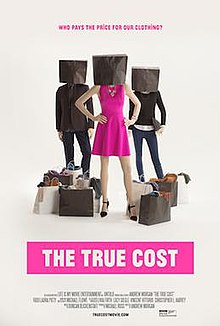The True Cost
| The True Cost | |
|---|---|

Theatrical release poster
|
|
| Directed by | Andrew Morgan |
| Produced by | Michael Ross |
| Music by | Duncan Blickenstaff |
| Edited by | Michael Ross |
|
Production
companies |
Life Is My Movie Entertainment
Untold Creative |
| Distributed by | BullFrog Films |
|
Release date
|
|
|
Running time
|
92 minutes |
| Country | United States |
| Language | English |
| Budget | US$500,000 |
The True Cost is a 2015 documentary film directed by Andrew Morgan that focuses on fast fashion. It discusses several aspects of the garment industry from production—mainly exploring the life of low-wage workers in developing countries—to its after-effects such as river and soil pollution, pesticide contamination, disease and death. Using an approach that looks at environmental, social and psychological aspects, it also examines consumerism and mass media, ultimately linking them to global capitalism. The documentary is a collage of several interviews with environmentalists, garment workers, factory owners, and people organizing fair trade companies or promoting sustainable clothing production.
Morgan's attention was drawn to the topic after the 2013 Savar building collapse, when a commercial building in Bangladesh named Rana Plaza toppled and killed over a thousand workers. Starting the project in October of that year, he traveled to thirteen countries to collect information and conduct interviews. The film was funded by Kickstarter and premiered at the 2015 Cannes Film Festival in early May 2015 before its release in select American and British theaters later that month. Critics have been both positive and dismissive, with reviews ranging from "vitally important documentary" to "vague liberal agitprop".
In The True Cost, Morgan examines the garment industry—specifically the fast fashion business— and links it to consumerism, globalization, capitalism, structural poverty, and oppression. In the film, it is stated that in the 1960s, the American fashion industry produced 95% of the clothes its people wore, while now only 3% percent are produced in the United States, with the rest produced in developing countries. Operating in countries such as Bangladesh, India, Cambodia, and China, major brand manufacturers minimize costs and maximize profits by having companies in those countries competing against each other. The international brands pressure the factory owners, threatening to close and move production to another country if the clothes are not cheap enough; the owners in turn pressure their workers and, as one owner says, "They're hampering me, I'm hampering my workers".
...
Wikipedia
